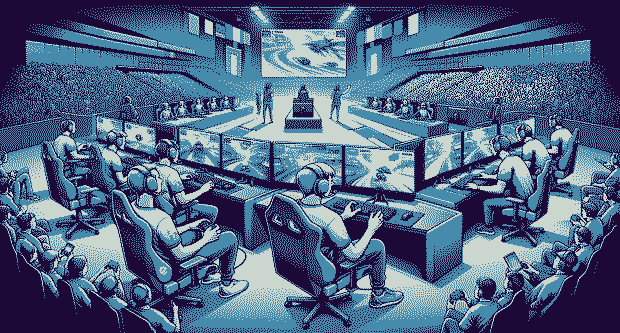Question: How you describe rise of e-sports in recent time and its impact on traditional sports viewership?
In recent years, e-sports—competitive video gaming—has surged in popularity, captivating millions of fans worldwide and creating a vibrant, rapidly growing industry. This rise has significant implications for traditional sports, particularly regarding viewership and fan engagement. This article explores the phenomenon of e-sports, its growing influence, and how it is reshaping the landscape of traditional sports entertainment.
Understanding E-Sports
1. What Are E-Sports?
E-sports, short for electronic sports, involves competitive gaming where players or teams compete in popular video games for prizes and recognition. These competitions can range from small local tournaments to massive global events, with games like “League of Legends,” “Dota 2,” “Counter-Strike: Global Offensive,” and “Fortnite” leading the charge. E-sports events are often streamed live on platforms like Twitch, YouTube Gaming, and Facebook Gaming, attracting millions of viewers.
2. The Growth of E-Sports
The growth of e-sports has been staggering. According to Newzoo’s Global Esports Market Report, the e-sports industry is expected to surpass $1.5 billion in revenue by 2024, driven by sponsorships, advertising, and media rights. The global e-sports audience is projected to reach 600 million people, demonstrating the broad appeal and significant market presence of competitive gaming.
E-Sports vs. Traditional Sports: A Comparative Analysis
1. Audience Demographics
E-sports have attracted a younger demographic compared to traditional sports. The average age of an e-sports viewer is typically between 18 and 34, whereas traditional sports fans tend to be older. This younger audience is digitally native and engages with content through streaming platforms and social media, setting e-sports apart from traditional sports that rely on television and in-person attendance.
2. Viewership Patterns
Traditional sports have long been dominated by television viewership, but e-sports are redefining how fans consume sports content. E-sports events are predominantly streamed online, allowing for interactive and immersive experiences. Viewers can engage with live chats, vote in polls, and follow multiple streams simultaneously, creating a more dynamic and participatory viewing experience compared to the passive nature of television sports.
3. Fan Engagement
E-sports excels in fan engagement through its use of digital platforms. Fans can interact with players and teams on social media, participate in online forums, and even influence game outcomes through voting and in-game events. Traditional sports, while still engaging, often lack the immediacy and interactivity offered by e-sports. The ability for fans to directly impact and interact with their favorite games and players has created a strong sense of community and involvement within the e-sports realm.
The Impact of E-Sports on Traditional Sports
1. Decline in Traditional Sports Viewership
The rise of e-sports has coincided with a noticeable decline in viewership for certain traditional sports. For instance, television ratings for some major sports leagues, like the NFL and NBA, have experienced fluctuations as younger audiences increasingly turn to e-sports for entertainment. This shift is particularly evident among millennials and Gen Z, who favor the interactive and digital nature of e-sports over traditional sports viewing experiences.
2. Changing Sponsorship and Advertising Trends
As e-sports gains traction, companies are reallocating their marketing and sponsorship budgets. Brands that traditionally invested heavily in traditional sports are now recognizing the value of reaching e-sports audiences. Major companies like Intel, Red Bull, and Coca-Cola have invested significantly in e-sports, sponsoring tournaments and teams. This shift in sponsorship and advertising dollars reflects the growing influence of e-sports and its potential to reach a highly engaged and lucrative audience.
3. Collaborations Between E-Sports and Traditional Sports
Interestingly, traditional sports organizations are beginning to embrace e-sports. Many professional sports leagues and teams have established their own e-sports divisions or partnered with e-sports organizations. For example, the NBA launched the NBA 2K League, a professional e-sports league based on the popular “NBA 2K” video game series. These collaborations serve as a bridge between traditional and digital sports, expanding the reach and appeal of both industries.
The Future of E-Sports and Traditional Sports Integration
1. Innovations in Fan Experience
The convergence of e-sports and traditional sports is likely to bring about innovative changes in fan experiences. Virtual reality (VR) and augmented reality (AR) technologies are being explored to enhance both e-sports and traditional sports viewing experiences. VR can provide immersive game viewing, while AR can offer real-time stats and interactive features for traditional sports fans.
2. Expanding Global Reach
E-sports is poised to continue its global expansion, with events increasingly attracting international audiences. The global nature of e-sports allows for cross-cultural exchanges and collaborations, potentially bringing new audiences to traditional sports. Conversely, traditional sports may benefit from the international exposure and digital innovations pioneered by the e-sports industry.
3. Evolving Revenue Models
The revenue models for both e-sports and traditional sports are evolving. E-sports is pioneering new revenue streams, such as in-game purchases and digital collectibles, which are gradually being adopted by traditional sports. Traditional sports may look to integrate similar digital revenue models to engage younger audiences and adapt to changing consumption patterns.
Challenges and Considerations
1. Regulatory and Integrity Issues
Both e-sports and traditional sports face challenges related to regulation and integrity. E-sports, in particular, has grappled with issues like match-fixing, doping, and player burnout. As e-sports continues to grow, establishing robust regulatory frameworks and ensuring fair play will be crucial for maintaining credibility and trust.
2. Balancing Digital and Physical Engagement
While e-sports offers unparalleled digital engagement, traditional sports provide a unique physical and communal experience. Balancing these aspects will be essential for both industries to thrive. Traditional sports organizations may need to incorporate more digital elements into their offerings, while e-sports may explore ways to enhance in-person event experiences.
Conclusion
The rise of e-sports has undoubtedly transformed the landscape of sports entertainment, challenging traditional sports in terms of viewership and fan engagement. As e-sports continues to grow, its influence on traditional sports will likely deepen, leading to new opportunities and innovations. By embracing digital advancements and exploring collaborations, both e-sports and traditional sports can coexist and flourish in an increasingly interconnected and diverse sports ecosystem. The future promises an exciting blend of interactive digital experiences and traditional sports passion, shaping the way we engage with and enjoy sports entertainment.



